Sports
Miss State Film Review: House of the Dragon
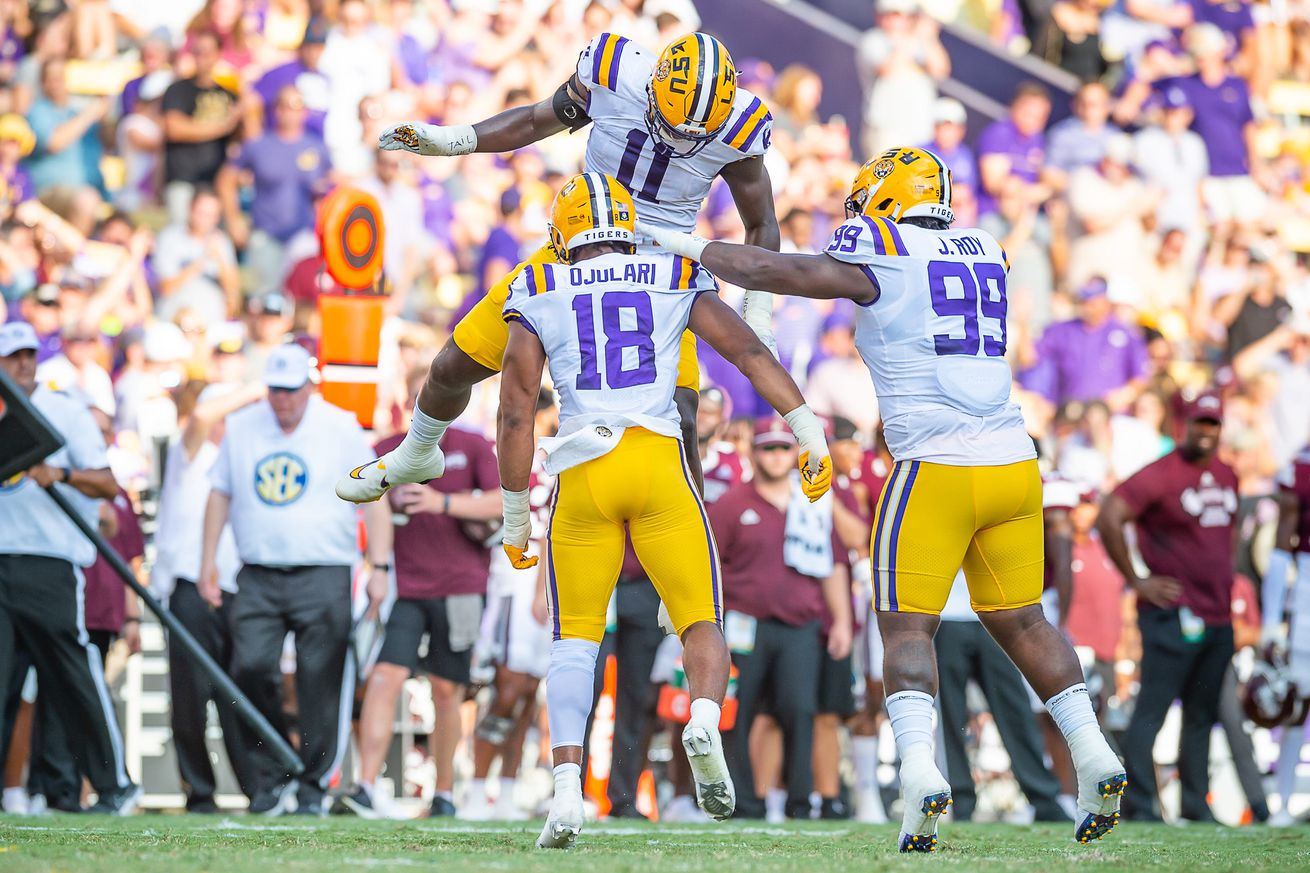

An Absolute Masterpiece
It doesn’t take a detailed, thousand-plus word film analysis for LSU fans to understand that their defense put the locks on everything Mississippi State tried to do. After suffering one and a half years through a regressive, static defense that was easy to exploit, this was as big a breath of fresh air as you could imagine. If I had to tell you what great, sound, modern defense looked like, I’d just turn on this game. Everything went right, they had an answer for everything. There are going to be plenty of things I simply don’t really get to in this that I noticed so I’ll just mention a couple of them now:
-They were unbelievable in mixing up their zone coverage structures and had people in the right places constantly. Additionally, their zone droppers were unbelievably sharp and did a great job constricting routes, cutting off everything in the distribution, and forcing Rogers to hold the ball. I mean, look at this:
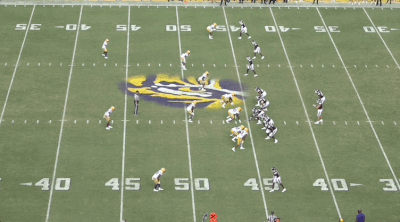
-Mekhi Garner was asked to play a fair amount of tight man coverage 1 on 1 and completely erased whoever he was covering, his length, strength, and technique were excellent and he could be a real one.
-On offense, the Jayden Daniels-not-pulling-the-trigger narrative is a real thing. It’s tough when you’re asked to really work through full progressions on straight dropback like a more advanced QB, but they are leaving a lot of meat on the bone in the passing game and it is going to get them shut-down at some point this year if it doesn’t change, they need more schemed up, designer stuff in the passing game to create explosives for Daniels instead of making him progress and find them.
But let’s focus on the defense, because it really, really looks like LSU has found a real one in Matt House.
Going into this game, I wanted him to simply do the things other teams did against the air raid. You get into dime and quarter (7 DBs), you play 3 high safeties, you play 3 down linemen, and you drop 8 into coverage. You forget about trying to rush the passer and you just throw resources at handling the route distributions. If you’re going to try to buck what everyone else does pretty successfully, you better have something perfect.
Matt House had something perfect, and something that is fairly replicable against non-air raid opponents. They almost never brought more than 4 (save for 4th and short), and they did drop 8 from time to time, but they did a lot more than that.
Jay Ward’s Big Day
Jay Ward played all over the field, dominating in all phases. His dominance as a downhill tackler was particularly instrumental, hunting down the screens that Mississippi State likes to use to steal cheap yardage against 2-3 high looks and off DBs. Against the air raid, it is critical that you have DBs that can come down and tackle in space. If you don’t, they’re going to be able to have a free 8-10 yards with a degree of frequency and stay ahead of schedule.
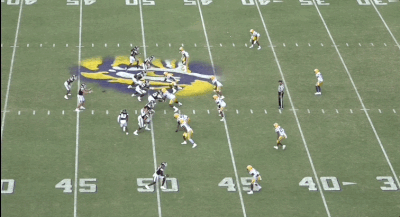
Mississippi State actually has the numbers they want here. The slide action by the WR adds an extra number to the frontside where they have 2 blockers to deal with 2 defenders. Jay Ward is able to dominate his blocker, get free, and make the TFL. When you have a guy who can just be better in a one-on-one situation like this, you can throw the offense’s numbers out the window.
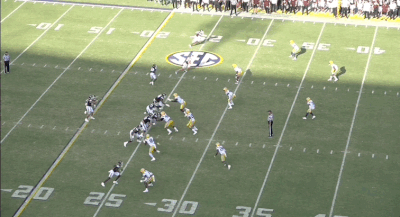
Another way Ward changed the math against these screens was by flying downhill and running the alley from 2 and 3 high structures. On this bubble to the number 3 receiver (3rd from the sideline), they have 2 receivers to account for the corner and the nickel. Normally, the offense is fine with throwing this because it’s pretty hard for the safety to get up and make the tackle before a 5-6 yard gain but Ward runs the alley and hunts him down a la Jamal Adams. He didn’t just tackle, he made plays in all facets, but this is where he had his biggest impact.
Short Yardage Dominance
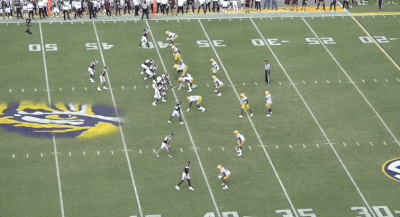
This is really due more to bad scheme by Mike Leach, but LSU was able to completely dominate in the several 4th and short situations MSU went for. It became pretty predictable that Leach was going to run inside zone on 4th and short, so in those situations, Matt House dialed up 0 pressures to overload the gaps and create run-throughs for TFLs. The real error in Leach’s strategy here was staying in his usual 4 wide structure. They basically never play tight ends, so you don’t have the guys to actually tighten up and pick up a yard when it’s predictable that you’re going to run it. When you’re in 4 open like this, the offense creates only 6 gaps. If the defense sends 6, they’re gapped out with a free body against an OL of only 5. If they send 7, they have two. This is one of the problems with the air raid in the modern day, you cannot go for it on 4th and 1 as much as other people because you can only run the ball from 4 open if the box is fairly empty. Matt House was able to completely overwhelm them in these situations and take the ball away. This happened several times exactly like this.
Recruit a TE and accept the end of your pure-form offense’s run, Mike. It’s over, all your disciples have done it already.
Simulating Pressure
Now we get to the real meat of this review. In order to understand modern defense, and to understand Matt House’s defense, you have to understand simulated pressures and creepers. Now, a lot of the time, those terms are used fairly interchangeably. In this piece and going forward I’m probably going to use them interchangeably as well, they sorta fall within the same broader concept. I personally consider creepers to be when one guy inserts and another guy drops out, and simulated pressures to be more wonky, multi-faceted pressure structures that still only send 4, but frankly they really blend together and there’s no real line of demarcation. For the sake of simplicity, I’m broadly going to use them interchangeably.
With the rise of spread offenses and high-volume passing attacks, it became important for defenses, especially those without top-of-the-line DB rooms, to ensure that they kept a full 7 in coverage whenever they can. However, even if you have good pass rushers, it can be hard to just have people rush head up and still generate pressure. I don’t care how good your front players are, you still need to be able to scheme up pressure to really attack an offense. Those two requirements were reconciled with the rise of simulated pressures and creepers as a dominant piece of a defense. Basically, you still only send 4, but you send people from different places on different paths to try to manipulate and attack protections, getting free rushers at the QB or scheming up really juicy matchups. Dave Aranda was one of the pioneers of creepers and sims as a foundation of your defense on the front end and has had massive, massive success in that regard.
On Saturday, that’s what Matt House did to attack Will Rogers. When you consider that in tandem with how sound and well-deployed their coverage structures were, you end up with a passing game with nowhere to go and not a lot of time to go there.
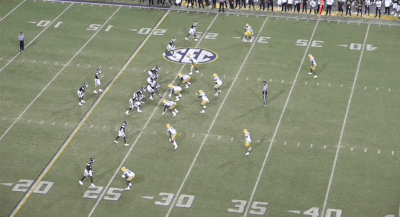
This is a great illustration of how a creeper/sim pressure can scheme up a free rusher WHILE keeping a full battery in your coverage. This is a Dave Aranda staple creeper known as “field slant” from their nickel package (pictured below). Ward inserts from the nickel position, but on the other end, BJ Ojulari drops out to play the curl/flat area. This allows the inside linebackers to play the hooks. The S (Greg Brooks here) can replace Ward and take the flat to the field. Since the offense has to account for Ojulari as a rusher pre-snap, this can create a free rusher as it does here. Against a 5 man pressure, throwing quick to the back like Rogers did on this spacing concept probably results in a solid gain, but with a creeper or simulated pressure, you get a full 7 in coverage to account for everyone. This is particularly useful against any hot or rush routes the QB may want to throw against a free rusher as well as anything else in the distribution. Simulated pressures are literally the best of both worlds.
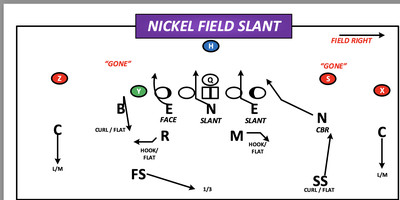
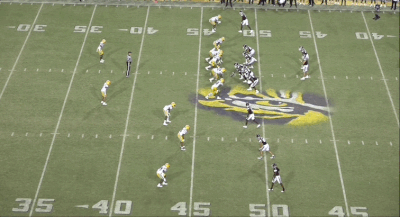
While the creeper doesn’t quite get home, it does trick Rogers into thinking they are sending pressure. He throws the slant from 3 to replace the pressure from the nickel with the ball, but the safety is there to account for it, keeping them short of the sticks.
The Dragon Package
Let me preface this by saying that I have no way of knowing if this is just LSU’s normal dime package, a specific pass-rush oriented package for this game, or a special pass-rush package that they will employ in obvious passing situations going forward that they happened to use every time they were in dime this week because it’s Mike Leach. I have no idea, it could just be “dime” and I’m being overwrought calling it something special.
HOWEVER, since I have no way of knowing, I’m gonna have some fun with it. When you consider the lethality of the players they deploy in this package, the fact that “dime” starts with “D,” and current TV phenomena, I will be calling this 2-3-6 package full of their best, most athletic pass rushers the “Dragon Package.” Usually, the package would consist of Harold Perkins-BJ Ojulari-Mekhi Wingo-Ali Gaye-Micah Baskerville up front, with the defensive backfield in dime with Sage Ryan as the 6th guy in. They used Greg Brooks as a more traditional dime player though when in Dragon.
If it turns out that this is just how they play dime, then dime is dragon now. The only way I’ll change it is if I find out what they ACTUALLY call it. Dragon is an appropriate name, as they absolutely lit Will Rogers and MSU’s protections on fire with it.
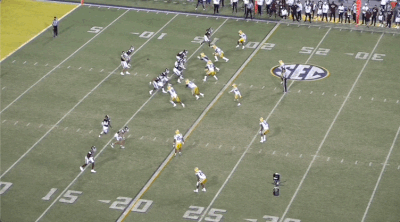
This package was incredibly diverse in its specific alignments, with all kinds of looks and structures. However generally, its usage was all about getting their best pass rushers on the field with only 1 interior, big-bodied DL on the field (Wingo). The package moved everyone around but really highlighted Harold Perkins as a nasty edge rusher. It did this with BJ Ojulari as well but he’s used that way all the time so it’s not that special, however, he was crazy effective from this package as well. This is a good illustration of just how FILTHY Harold Perkins was as an edge rusher on Saturday (baby Micah Parsons). Here he is with a great swipe to prevent the tackle from getting hands on him and winning inside. Some great bend off the edge by Ojulari as well to beat his man. On the back-end, you can see how well Matt House deployed zone coverages. Here, they’re able to take away 3×1 4 verts with a Cover 3 Buzz type structure with the weak safety’s rotation staying at depth to cut off the special route from the number 3 receiver.

Once again, the package really weaponized the pure pass-rushing talent of Harold Perkins and BJ Ojulari. Out of this, those two were able to really tee off and get after the QB. Mississippi State is never going to leave more than 6 in the protection in any capacity, so you are going to get at least one of those guys in a 1 on 1 situation, both in this case. Great speed and bend off the edge by Perkins and an excellent win on a nice swim move by Ojulari.
Simulating Pressure from the Dragon Package

This is where the earlier background on simulated pressures comes into play, because, while they simulated pressure from nickel plenty as well, this is REALLY what they got into dragon to do. They used diverse alignments to sim pressure and get after the damn quarterback while keeping a fully robust coverage structure on the back end. This is one of the main simulated pressures they utilized from this package. Basically, Perkins will walk up on the inside of the NOSE away from the back and, at the snap, insert into the opposite A gap. So, most college pass protections boil down to a half-slide. One side of the line will slide, and the other half of the line will protect in a big on big/back on backer man-to-man style (pictured below).
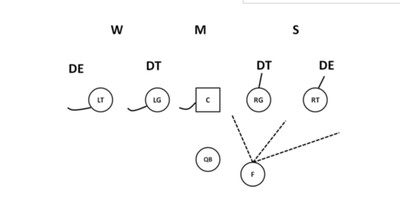
(CougCenter)
So what LSU is trying to attack is the A gap opposite the slide. The reason I think they set the gap Perkins will insert into to the back is that teams will, way more often than not, slide AWAY from the back. This means that you get Perkins 1 on 1 up the A gap with the running back. Any time you can get a premium pass rusher 1 on 1 with a back in the protection, that’s what you want. Roy occupies the center and opens up the A gap. Perkins dispatches the running back and gets right to the QB. Once again, on the back end, there are still 7 in coverage and their 3 Buzz look takes care of the route distribution.
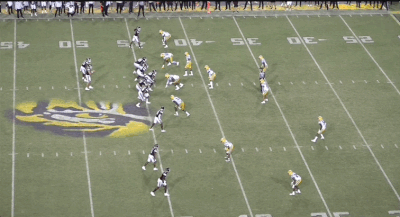
Another sim pressure path they used a lot was this bluff drop delayed insert deal, which they played quarters behind here (weak safety poaches on the number 3 receiver). They bait the back into check releasing and the guard into helping on the nose, which frees up the A gap. Perkins inserts right behind the guard and is free to the QB, forcing him to check the ball down where there is a hook defender ready to run him down because, again, there are still 7 in coverage. LSU ran this a handful of times and it’s pretty sinister. BJ Ojulari displays a nasty ghost move to beat his man 1 v 1 off the edge as well.

This is a nasty path for them to have off of their other one from this front. In the other, Perkins will, as stated earlier, insert in the A gap to the back. Here, he bluffs in that direction and inserts into the A gap away from him. Really nice sequencing here. It’s unfortunate this was a screen.

Just a really, really nasty look here from House. So to the boundary, they line up 3 rushers outside of the guard. This makes it really difficult for the center to get to the innermost of those three guys, getting 3 rushers on just the guard and tackle if he can’t get there. On the other side, they present 3 additional pass rush threats that the offense has to account for in their protection:

So while they’re going to slide (the 3-man slide side of half slide) the protection to the boundary, they have to have the backside guard, backside tackle, and running back account for the threats to the man side. The back’s first step to that side makes it incredibly difficult for him to actually get to the side of the pressure in an emergency. So to sum it up
-The center is put in no man’s land, they have 3 guys on just 2 OL
-The back has responsibility front side and has to rush to the other side if he wants to take anybody.
The 3 rushers overwhelm their 2 OL and the back takes the lowest danger rusher (least direct path to the QB) instead of the highest and Saivion Jones (in for Ali Gaye here) gets a sack. Behind it, they look to be playing 2-man (also known as cover 5 and 2-man under) and cover everything up well, which they can do because they are sending just 4 and still have a full 7 in coverage. Despite all of the bells and whistles, despite all of the stress they put on protections, still just 4.
Simulated pressures/creepers are the hallmark of a modern defense for a reason, and LSU runs them as well and with as much multiplicity as anybody thanks to Matt House.


